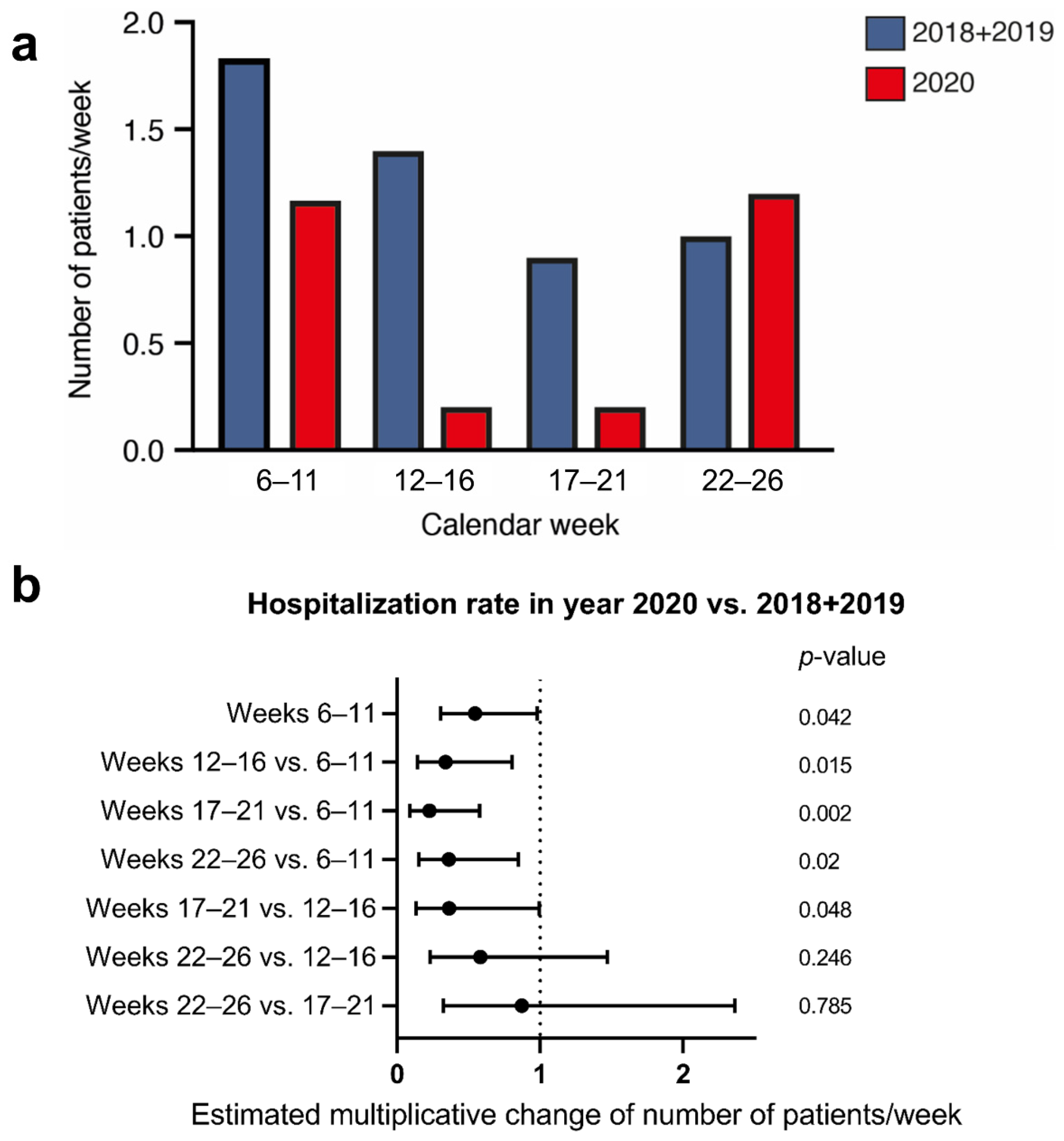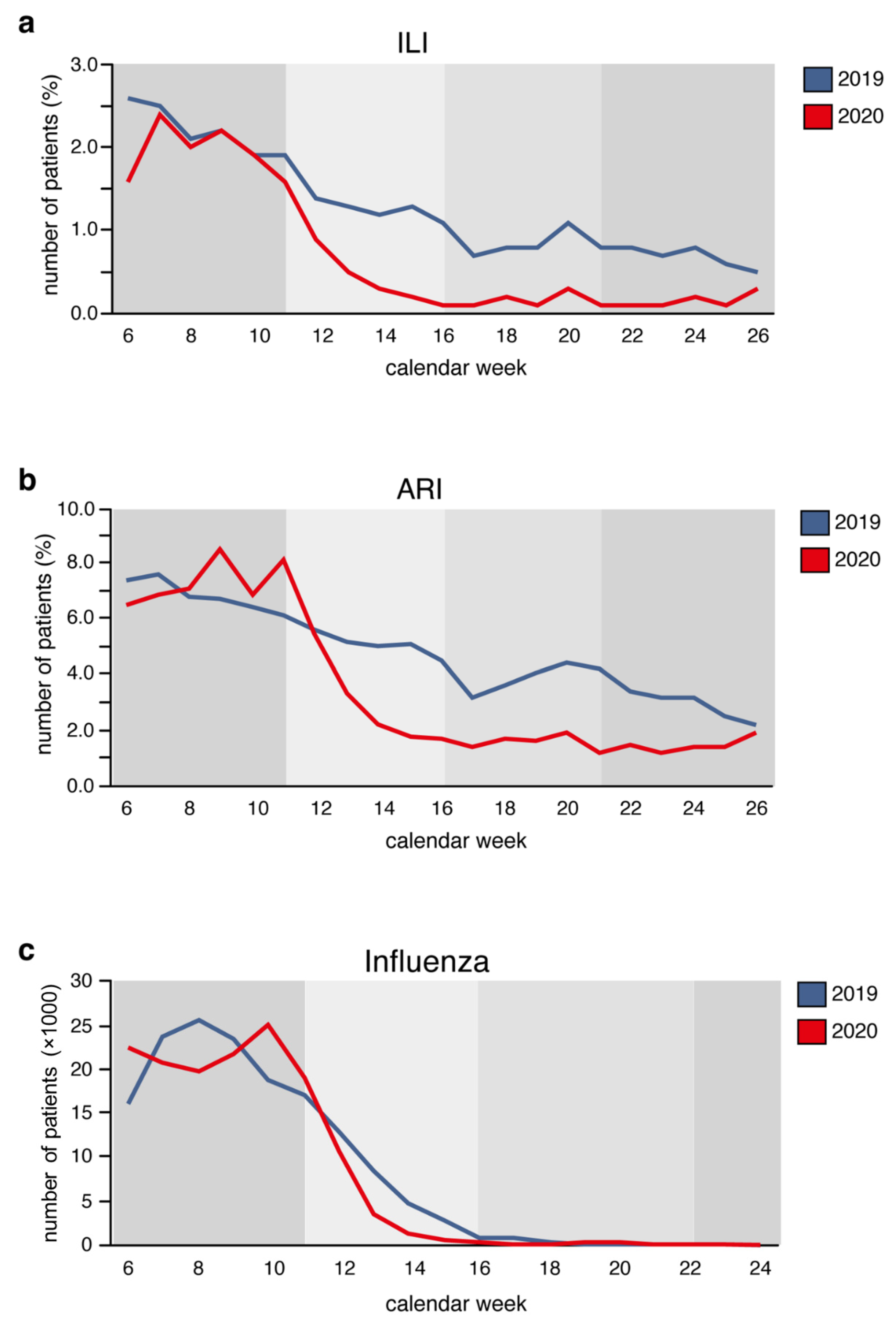Aneurysmal Subarachnoid Hemorrhage during the Shutdown for COVID-19
Abstract
:1. Introduction
2. Materials and Methods
2.1. Time Periods
2.2. Mortality
2.3. Preclinical Data
2.4. Influenza and Other Respiratory Viruses
2.5. Air Pollution
2.6. Statistics
2.7. Ethic
3. Results
3.1. SAH before Shutdown
3.2. SAH during the Shutdown
3.3. Case Severity in the Neuro Emergency Department
3.4. Mortality
3.5. Influenza and Other Respiratory Viruses
3.6. Air Pollution
4. Discussion
4.1. Neuro Emergency Department and Referral within the Neurovascular Network
4.2. Air Pollution
5. Conclusions
Author Contributions
Funding
Institutional Review Board Statement
Informed Consent Statement
Data Availability Statement
Acknowledgments
Conflicts of Interest
References
- Slagman, A.; Behringer, W.; Greiner, F.; Klein, M.; Weismann, D.; Erdmann, B.; Pigorsch, M.; Möckel, M. Medical Emergencies During the COVID-19 Pandemic. Dtsch. Arztebl. Int. 2020, 117, 545–552. [Google Scholar] [CrossRef] [PubMed]
- De Rosa, S.; Spaccarotella, C.; Basso, C.; Calabrò, M.P.; Curcio, A.; Filardi, P.P.; Mancone, M.; Mercuro, G.; Muscoli, S.; Nodari, S.; et al. Reduction of hospitalizations for myocardial infarction in Italy in the COVID-19 era. Eur. Heart J. 2020, 41, 2083–2088. [Google Scholar] [CrossRef]
- Andreasen, T.H.; Bartek, J.; Andresen, M.; Springborg, J.B.; Romner, B. Modifiable risk factors for aneurysmal subarachnoid hemorrhage. Stroke 2013, 44, 3607–3612. [Google Scholar] [CrossRef] [PubMed]
- Shao, L.; Qin, X.; Liu, J.; Jian, Z.; Xiong, X.; Liu, R. Macrophage Polarization in Cerebral Aneurysm: Perspectives and Potential Targets. J. Immunol. Res. 2017, 2017, 8160589. [Google Scholar] [CrossRef] [Green Version]
- Güresir, E.; Coch, C.; Fimmers, R.; Ilic, I.; Hadjiathanasiou, A.; Kern, T.; Brandecker, S.; Güresir, Á.; Velten, M.; Vatter, H.; et al. Initial inflammatory response is an independent predictor of unfavorable outcome in patients with good-grade aneurysmal subarachnoid hemorrhage. J. Crit. Care 2020, 60, 45–49. [Google Scholar] [CrossRef] [PubMed]
- Chalouhi, N.; Hoh, B.L.; Hasan, D. Review of cerebral aneurysm formation, growth, and rupture. Stroke 2013, 44, 3613–3622. [Google Scholar] [CrossRef]
- Xu, J.; Yalkun, G.; Wang, M.; Wang, A.; Wangqin, R.; Zhang, X.; Chen, Z.; Mo, J.; Meng, X.; Li, H.; et al. Impact of Infection on the Risk of Recurrent Stroke Among Patients With Acute Ischemic Stroke. Stroke 2020, 51, 2395–2403. [Google Scholar] [CrossRef]
- Han, M.-H.; Yi, H.-J.; Ko, Y.; Kim, Y.-S.; Lee, Y.-J. Association between hemorrhagic stroke occurrence and meteorological factors and pollutants. BMC Neurol. 2016, 16, 59. [Google Scholar] [CrossRef] [Green Version]
- Barnes, M.; Heywood, A.E.; Mahimbo, A.; Rahman, B.; Newall, A.T.; MacIntyre, C.R. Acute myocardial infarction and influenza: A meta-analysis of case-control studies. Heart 2015, 101, 1738–1747. [Google Scholar] [CrossRef] [Green Version]
- MacIntyre, C.R.; Mahimbo, A.; Moa, A.M.; Barnes, M. Influenza vaccine as a coronary intervention for prevention of myocardial infarction. Heart 2016, 102, 1953–1956. [Google Scholar] [CrossRef] [Green Version]
- Vermeulen, M.J.; Schull, M.J. Missed diagnosis of subarachnoid hemorrhage in the emergency department. Stroke 2007, 38, 1216–1221. [Google Scholar] [CrossRef] [PubMed] [Green Version]
- van Gijn, J.; Rinkel, G.J. Subarachnoid haemorrhage: Diagnosis, causes and management. Brain 2001, 124, 249–278. [Google Scholar] [CrossRef] [PubMed]
- Hop, J.W.; Rinkel, G.J.; Algra, A.; van Gijn, J. Initial loss of consciousness and risk of delayed cerebral ischemia after aneurysmal subarachnoid hemorrhage. Stroke 1999, 30, 2268–2271. [Google Scholar] [CrossRef] [Green Version]
- Walendy, V.; Strauss, C.; Rachinger, J.; Stang, A. Treatment of aneurysmal subarachnoid haemorrhage in Germany: A nationwide analysis of the years 2005–2009. Neuroepidemiology 2014, 42, 90–97. [Google Scholar] [CrossRef]
- De Rooij, N.K.; Linn, F.H.H.; van der Plas, J.A.; Algra, A.; Rinkel, G.J.E. Incidence of subarachnoid haemorrhage: A systematic review with emphasis on region, age, gender and time trends. J. Neurol. Neurosurg. Psychiatry 2007, 78, 1365–1372. [Google Scholar] [CrossRef]
- Zaremba, S.; Albus, L.; Schuss, P.; Vatter, H.; Klockgether, T.; Güresir, E. Increased risk for subarachnoid hemorrhage in patients with sleep apnea. J. Neurol. 2019, 266, 1351–1357. [Google Scholar] [CrossRef]
- Bayer, C.; Remschmidt, C.; an der Heiden, M.; Tolksdorf, K.; Herzhoff, M.; Kaersten, S.; Buda, S.; Haas, W.; Buchholz, U. Internet-based syndromic monitoring of acute respiratory illness in the general population of Germany, weeks 35/2011 to 34/2012. EuroSurveill. 2014, 19, 20684. [Google Scholar] [CrossRef] [PubMed] [Green Version]
- Saand, A.R.; Yu, F.; Chen, J.; Chou, S.H.-Y. Systemic inflammation in hemorrhagic strokes—A novel neurological sign and therapeutic target? J. Cereb. Blood Flow Metab. 2019, 39, 959–988. [Google Scholar] [CrossRef]
- Güresir, E.; Vatter, H.; Schuss, P.; Platz, J.; Konczalla, J.; de Du Rochement, R.M.; Berkefeld, J.; Seifert, V. Natural history of small unruptured anterior circulation aneurysms: A prospective cohort study. Stroke 2013, 44, 3027–3031. [Google Scholar] [CrossRef] [Green Version]
- Smeeth, L.; Thomas, S.L.; Hall, A.J.; Hubbard, R.; Farrington, P.; Vallance, P. Risk of myocardial infarction and stroke after acute infection or vaccination. N. Engl. J. Med. 2004, 351, 2611–2618. [Google Scholar] [CrossRef] [Green Version]
- Lee, K.R.; Bae, J.H.; Hwang, I.C.; Kim, K.K.; Suh, H.S.; Ko, K.D. Effect of Influenza Vaccination on Risk of Stroke: A Systematic Review and Meta-Analysis. Neuroepidemiology 2017, 48, 103–110. [Google Scholar] [CrossRef] [PubMed] [Green Version]
- Grau, A.J.; Urbanek, C.; Palm, F. Common infections and the risk of stroke. Nat. Rev. Neurol. 2010, 6, 681–694. [Google Scholar] [CrossRef] [PubMed]
- Boehme, A.K.; Luna, J.; Kulick, E.R.; Kamel, H.; Elkind, M.S.V. Influenza-like illness as a trigger for ischemic stroke. Ann. Clin. Transl. Neurol. 2018, 5, 456–463. [Google Scholar] [CrossRef] [PubMed]
- Kunze, A.K.; Annecke, A.; Wigger, F.; Lichy, C.; Buggle, F.; Schnippering, H.; Schnitzler, P.; Grau, A.J. Recent infection as a risk factor for intracerebral and subarachnoid hemorrhages. Cerebrovasc. Dis. 2000, 10, 352–358. [Google Scholar] [CrossRef]
- Backes, D.; Rinkel, G.J.E.; Algra, A.; Vaartjes, I.; Donker, G.A.; Vergouwen, M.D.I. Increased incidence of subarachnoid hemorrhage during cold temperatures and influenza epidemics. J. Neurosurg. 2016, 125, 737–745. [Google Scholar] [CrossRef] [Green Version]
- Naghavi, M.; Wyde, P.; Litovsky, S.; Madjid, M.; Akhtar, A.; Naguib, S.; Siadaty, M.S.; Sanati, S.; Casscells, W. Influenza infection exerts prominent inflammatory and thrombotic effects on the atherosclerotic plaques of apolipoprotein E-deficient mice. Circulation 2003, 107, 762–768. [Google Scholar] [CrossRef] [Green Version]
- Gorr, M.W.; Falvo, M.J.; Wold, L.E. Air Pollution and Other Environmental Modulators of Cardiac Function. Compr. Physiol. 2017, 7, 1479–1495. [Google Scholar] [CrossRef]
- Brook, R.D.; Rajagopalan, S.; Pope, C.A.; Brook, J.R.; Bhatnagar, A.; Diez-Roux, A.V.; Holguin, F.; Hong, Y.; Luepker, R.V.; Mittleman, M.A.; et al. Particulate matter air pollution and cardiovascular disease: An update to the scientific statement from the American Heart Association. Circulation 2010, 121, 2331–2378. [Google Scholar] [CrossRef] [Green Version]
- Cohen, A.J.; Brauer, M.; Burnett, R.; Anderson, H.R.; Frostad, J.; Estep, K.; Balakrishnan, K.; Brunekreef, B.; Dandona, L.; Dandona, R.; et al. Estimates and 25-year trends of the global burden of disease attributable to ambient air pollution: An analysis of data from the Global Burden of Diseases Study 2015. Lancet 2017, 389, 1907–1918. [Google Scholar] [CrossRef] [Green Version]
- Calderón-Garcidueñas, L.; Azzarelli, B.; Acuna, H.; Garcia, R.; Gambling, T.M.; Osnaya, N.; Monroy, S.; Del Tizapantzi, M.R.; Carson, J.L.; Villarreal-Calderon, A.; et al. Air pollution and brain damage. Toxicol. Pathol. 2002, 30, 373–389. [Google Scholar] [CrossRef]
- Shah, A.S.V.; Lee, K.K.; McAllister, D.A.; Hunter, A.; Nair, H.; Whiteley, W.; Langrish, J.P.; Newby, D.E.; Mills, N.L. Short term exposure to air pollution and stroke: Systematic review and meta-analysis. BMJ 2015, 350, h1295. [Google Scholar] [CrossRef] [PubMed] [Green Version]
- Li, W.; Dorans, K.S.; Wilker, E.H.; Rice, M.B.; Ljungman, P.L.; Schwartz, J.D.; Coull, B.A.; Koutrakis, P.; Gold, D.R.; Keaney, J.F.; et al. Short-Term Exposure to Ambient Air Pollution and Biomarkers of Systemic Inflammation: The Framingham Heart Study. Arterioscler. Thromb. Vasc. Biol. 2017, 37, 1793–1800. [Google Scholar] [CrossRef] [PubMed] [Green Version]
- Li, Y.; Rittenhouse-Olson, K.; Scheider, W.L.; Mu, L. Effect of particulate matter air pollution on C-reactive protein: A review of epidemiologic studies. Rev. Environ. Health 2012, 27, 133–149. [Google Scholar] [CrossRef] [Green Version]
- Li, X.-Y.; Yu, X.-B.; Liang, W.-W.; Yu, N.; Wang, L.; Ye, X.-J.; Chen, K.; Bian, P.-D. Meta-analysis of association between particulate matter and stroke attack. CNS Neurosci. Ther. 2012, 18, 501–508. [Google Scholar] [CrossRef]
- Kivimäki, M.; Jokela, M.; Nyberg, S.T.; Singh-Manoux, A.; Fransson, E.I.; Alfredsson, L.; Bjorner, J.B.; Borritz, M.; Burr, H.; Casini, A.; et al. Long working hours and risk of coronary heart disease and stroke: A systematic review and meta-analysis of published and unpublished data for 603 838 individuals. Lancet 2015, 386, 1739–1746. [Google Scholar] [CrossRef] [Green Version]
- Menut, L.; Bessagnet, B.; Siour, G.; Mailler, S.; Pennel, R.; Cholakian, A. Impact of lockdown measures to combat COVID-19 on air quality over western Europe. Sci. Total Environ. 2020, 741, 140426. [Google Scholar] [CrossRef]
- Chen, K.; Wang, M.; Huang, C.; Kinney, P.L.; Anastas, P.T. Air pollution reduction and mortality benefit during the COVID-19 outbreak in China. Lancet Planet. Health 2020, 4, e210–e212. [Google Scholar] [CrossRef]
- Klemperer, E.M.; West, J.C.; Peasley-Miklus, C.; Villanti, A.C. Change in Tobacco and Electronic Cigarette Use and Motivation to Quit in Response to COVID-19. Nicotine Tob. Res. 2020, 22, 1662–1663. [Google Scholar] [CrossRef]





| 2019 Calendar Weeks 6–26 | 2020 Calendar Weeks 6–26 | |
|---|---|---|
| No. of patients | 32 | 15 |
| Mean age (years) | 55 ± 12 | 56 ± 12 |
| WFNS grade | 3 ± 1 | 4 ± 2 |
| Fisher grade 3 | 30 (94%) | 14 (93%) |
| Female gender | 18 (56%) | 9 (60%) |
| Tobacco use | 16 (50%) | 7 (47%) |
| Arterial hypertension | 16 (50%) | 6 (40%) |
| Mean aneurysm size (mm) | 6.7 ± 3.7 | 5.6 ± 0.5 |
| Aneurysm location | ||
| AComA + ACA | 13 (41%) | 7 (47%) |
| ICA | 5 (16%) | 3 (20%) |
| MCA | 11 (34%) | 3 (20%) |
| Posterior circulation | 3 (9%) | 2 (13%) |
| Time from ictus to hospitalization (h) | 7 ± 2 | 5 ± 2 |
Publisher’s Note: MDPI stays neutral with regard to jurisdictional claims in published maps and institutional affiliations. |
© 2022 by the authors. Licensee MDPI, Basel, Switzerland. This article is an open access article distributed under the terms and conditions of the Creative Commons Attribution (CC BY) license (https://creativecommons.org/licenses/by/4.0/).
Share and Cite
Güresir, E.; Gräff, I.; Seidel, M.; Bauer, H.; Coch, C.; Diepenseifen, C.; Dohmen, C.; Engels, S.; Hadjiathanasiou, A.; Heister, U.; et al. Aneurysmal Subarachnoid Hemorrhage during the Shutdown for COVID-19. J. Clin. Med. 2022, 11, 2555. https://doi.org/10.3390/jcm11092555
Güresir E, Gräff I, Seidel M, Bauer H, Coch C, Diepenseifen C, Dohmen C, Engels S, Hadjiathanasiou A, Heister U, et al. Aneurysmal Subarachnoid Hemorrhage during the Shutdown for COVID-19. Journal of Clinical Medicine. 2022; 11(9):2555. https://doi.org/10.3390/jcm11092555
Chicago/Turabian StyleGüresir, Erdem, Ingo Gräff, Matthias Seidel, Hartmut Bauer, Christoph Coch, Christian Diepenseifen, Christian Dohmen, Susanne Engels, Alexis Hadjiathanasiou, Ulrich Heister, and et al. 2022. "Aneurysmal Subarachnoid Hemorrhage during the Shutdown for COVID-19" Journal of Clinical Medicine 11, no. 9: 2555. https://doi.org/10.3390/jcm11092555
APA StyleGüresir, E., Gräff, I., Seidel, M., Bauer, H., Coch, C., Diepenseifen, C., Dohmen, C., Engels, S., Hadjiathanasiou, A., Heister, U., Heyer, I., Lampmann, T., Paus, S., Petzold, G., Pöhlau, D., Putensen, C., Schneider, M., Schuss, P., Textor, J., ... Vatter, H. (2022). Aneurysmal Subarachnoid Hemorrhage during the Shutdown for COVID-19. Journal of Clinical Medicine, 11(9), 2555. https://doi.org/10.3390/jcm11092555












